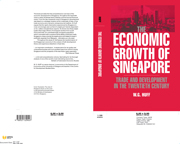Book contents
- Frontmatter
- Contents
- List of figures
- List of tables
- Preface and acknowledgements
- Abbreviations and conventions
- Geographical definitions
- Introduction
- Part One Themes and beginnings
- Part Two Development as a staple port, 1900–1939
- 3 Trade, finance and development
- 4 Ocean-going shipping, the port and regional transport
- 5 Immigration, population and employment
- 6 Rubber: boom and spread of a twentieth-century staple
- 7 Rubber, industrialization and the development of Chinese banking
- 8 Petroleum and tin: the twentieth-century boom commodity and a staple in decline
- 9 The distribution of manufactured imports
- Part Three Staple port and rapid growth, 1947–1990
- 12 Conclusion
- Appendix tables
- Bibliography
- Index
4 - Ocean-going shipping, the port and regional transport
Published online by Cambridge University Press: 22 September 2009
- Frontmatter
- Contents
- List of figures
- List of tables
- Preface and acknowledgements
- Abbreviations and conventions
- Geographical definitions
- Introduction
- Part One Themes and beginnings
- Part Two Development as a staple port, 1900–1939
- 3 Trade, finance and development
- 4 Ocean-going shipping, the port and regional transport
- 5 Immigration, population and employment
- 6 Rubber: boom and spread of a twentieth-century staple
- 7 Rubber, industrialization and the development of Chinese banking
- 8 Petroleum and tin: the twentieth-century boom commodity and a staple in decline
- 9 The distribution of manufactured imports
- Part Three Staple port and rapid growth, 1947–1990
- 12 Conclusion
- Appendix tables
- Bibliography
- Index
Summary
By World War I Singapore was the seventh busiest port in the world in terms of shipping tonnage handled; in the 1920s over 50 different lines stopped there. Ocean-going shipping was neither organized from Singapore nor built up with it in mind. But merchants in the city could draw on passing international shipping traffic to lift exports, with the result that Singapore had a readily available supply of tonnage. Within this framework of economic growth dependent on a largely exogenously determined flow of world shipping, three questions specific to Singapore arise: the effect of the introduction of the shipping conference system; the provision of adequate port facilities; and the need to develop regional transport. After examining the pattern of ocean-going shipping in section I of this chapter, each of these issues is considered respectively in sections II to IV.
Three streams of outward-bound shipping from the West converged on Singapore – one using the Suez Canal, a second taking the Cape route and joining the Suez stream in the area of the Indian subcontinent, and a third beginning in the Indian area. Beyond Singapore shipping fanned out, partly to termini in Siam, Indo-China, British Borneo and Netherlands India, and partly as a main stream to Far Eastern ports. In returning and now sailing ‘homewards’ in the direction of the United Kingdom, these streams of shipping again came together at Singapore.
- Type
- Chapter
- Information
- The Economic Growth of SingaporeTrade and Development in the Twentieth Century, pp. 120 - 149Publisher: Cambridge University PressPrint publication year: 1994

